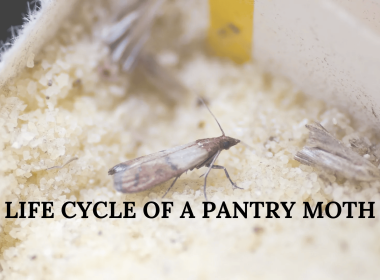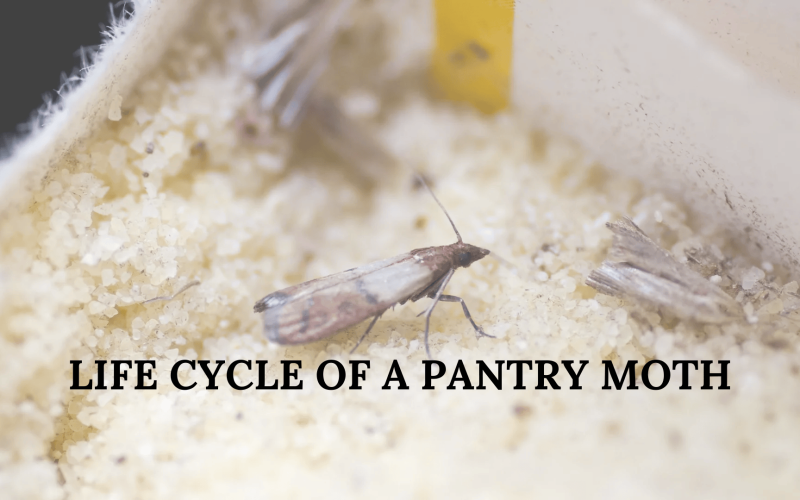Pantry moths are small pests that can quickly infest your kitchen and damage food storage.
These insects are notorious for ruining grains, dried fruit, and other pantry staples.
Understanding the pantry moth life cycle is key to preventing and controlling an infestation.
By learning how these pests grow and reproduce, you can take steps to stop them before they spread.
In this blog, we’ll discuss each stage of the pantry moth’s life cycle—egg, larva, pupa, and adult—and share tips on how to identify and prevent them.
With simple, easy-to-follow advice, you’ll be able to protect your pantry and keep it moth-free.
The Pantry Moth Life Cycle

The pantry moth goes through four stages in its life cycle: egg, larva, pupa, and adult. Understanding each stage will help you spot infestations early and take action.
Here’s a quick look at the stages:
- Egg Stage: The first stage, where moths lay eggs in food.
- Larva Stage: The larvae hatch and start feeding on the food.
- Pupa Stage: Larvae turn into pupae, preparing to become adults.
- Adult Stage: The moths emerge, mate, and lay eggs to start the cycle again.
Each stage has its signs and ways to prevent it. Let’s look at each one in more detail.
Stage 1: Egg Stage
The pantry moth’s life cycle begins with tiny eggs, which are often laid directly in or near food like grains, flour, or dried fruit.
- Where They Lay Eggs: Pantry moths tend to lay their eggs in cracks, along the edges of food packages, or in places where food has spilled or accumulated.
- How Long It Lasts: The egg stage typically lasts 4 to 6 days before hatching.
- Signs of an Infestation: The eggs themselves are hard to see, but larvae may quickly hatch, so it’s important to check for signs of them.
To Prevent the Egg Stage:
- Store food in airtight containers to block moths from laying eggs.
- Regularly inspect pantry shelves for any cracks, food spills, or signs of pests.
- Throw away expired or old food, as pantry moths love to lay eggs in these items.
Stage 2: Larva Stage
Once the eggs hatch, they turn into larvae. These larvae are small, worm-like creatures that feed on stored food.
- Characteristics: Larvae are typically white or light brown and can be found crawling in your pantry, usually inside food packages.
- What They Feed On: Larvae eat grains, nuts, dried fruits, and other dry pantry foods. They create small holes in packaging and may leave behind webbing.
- Damage: The larvae can contaminate food, making it unsafe to eat. Their feeding can also cause food to spoil faster.
- How to Identify Larvae: Look for small, moving worms or webbing in food packages. If you see these, it’s likely you have larvae in your pantry.
To Prevent Larvae:
- Seal food tightly in airtight containers to keep larvae out.
- Regularly check food for signs of larvae or webbing.
- Clean pantry shelves thoroughly and remove any spilled food.
Stage 3: Pupa Stage
The pupa stage is when larvae grow into adult moths. During this stage, the larvae stop feeding and form a protective cocoon around themselves.
- What Happens: The larvae spin a cocoon and become pupae. Inside the cocoon, they undergo metamorphosis to become adult moths.
- How Long It Lasts: The pupa stage typically lasts 10 to 14 days, depending on temperature and food availability.
- Signs of Pupa: You might find pupae in food packaging or on pantry shelves. They are usually hidden within food or cracks, making them harder to spot.
To Prevent Pupae:
- Clean pantry shelves regularly, especially in corners and crevices.
- Check food containers and discard any that show signs of moth activity.
- Ensure pantry shelves are dry and free from food debris.
Stage 4: Adult Stage
The adult stage is when pantry moths become fully grown and ready to reproduce. This is the final stage of their life cycle.
- Characteristics: Adult pantry moths have brown wings with a distinct dark spot near the center. They are small, measuring about 1/2 inch long.
- Reproduction: After emerging, adult moths mate and lay eggs, starting the cycle over again. They often lay eggs in or near food items.
- Identification: Adult moths are often seen flying around the pantry, especially during the evening when they are most active.
- Control Methods: If you see adult moths, it’s important to act quickly. Use moth traps to capture them and stop the mating process.
To Control Adult Moths:
- Set up moth traps to monitor activity and reduce the adult population.
- Seal entry points and cracks in pantry shelves to keep them from coming back.
- Remove infested food to prevent new eggs from being laid.
Pantry Moth Webbing

Webbing is one of the most noticeable signs of a pantry moth infestation.
When pantry moth larvae feed on food, they often create a web-like structure to protect themselves and move through food packages.
What is Webbing?
Webbing looks like thin, silky strands that appear in food packaging, cracks, and corners of your pantry. It’s the result of larvae creating a protective cocoon as they feed and grow.
Where You’ll Find It
Webbing is often found inside cereal boxes, bags of flour, rice, nuts, or dried fruit. It can also appear around the edges of food containers or in small gaps and cracks in pantry shelves.
Why It’s a Problem
Webbing indicates that larvae are actively feeding on food, contaminating it. This webbing can damage food packaging, leading to further contamination and spoilage.
How to Deal with Webbing
If you notice webbing in your pantry, remove and discard any contaminated food immediately.
Clean the area thoroughly by vacuuming up any webs and wiping down the shelves with soapy water.
Be sure to inspect nearby food items for any signs of larvae or additional webbing.
By addressing the webbing early, you can stop the infestation before it spreads and prevent further damage to your pantry and food.
Factors Affecting the Life Cycle of Pantry Moth
Several factors can influence how quickly pantry moths go through their life cycle. Understanding these factors helps you better manage and prevent infestations.
Temperature plays a big role in how fast pantry moths develop. Warmer temperatures speed up the process. Eggs hatch faster, and larvae grow more quickly in warmer environments.
If the pantry is kept at room temperature or higher, the life cycle can be completed much faster, leading to faster infestations.
Food availability is another important factor. The more food moths have to feed on, the better the conditions are for their growth and reproduction.
Pantry moths thrive in areas where food is plentiful, especially grains, dried fruits, and nuts. The more food in your pantry, the faster moths can breed and complete their life cycle.
To slow down the life cycle and prevent infestations:
- Keep your pantry cool and dry to discourage moths from developing quickly.
- Regularly clean your pantry and remove expired or old food that could attract moths.
By controlling temperature and food availability, you can significantly reduce the chances of a pantry moth infestation.
Common Signs of Pantry Moth Infestation

It’s important to catch pantry moth infestations early to prevent them from spreading.
Here are some common signs to watch for:
- Webbing: Look for small, silky webs in food packages or on pantry shelves. This is a sign that larvae are feeding and creating their protective webbing.
- Larvae: You may see tiny worms (larvae) crawling around in food or packaging. They are usually light-colored or pale.
- Adult Moths: Adult moths flying around the pantry are another clear sign of an infestation. They are usually active in the evening.
- Holes in Food Packaging: Pantry moth larvae can chew through packaging, leaving behind small holes. Check food packages for any signs of damage.
To Stop an Infestation from Growing:
- Regularly inspect your pantry for these signs.
- Clean up crumbs or spilled food, which attract moths.
- Remove any food that shows signs of contamination.
How Pantry Moths Spread

Pantry moths can spread quickly within your kitchen and pantry. Understanding how they move can help you contain an infestation before it grows.
Moths don’t just fly around; they often spread by crawling from one food item to another. They can easily move between packages, especially if food packaging is damaged or cracked.
Once they hatch, larvae crawl from one package to another, spreading the infestation to nearby food items. Once adult moths emerge, they can lay eggs in new food packages.
These eggs can hatch and start the cycle over, making it easier for the infestation to spread throughout the pantry.
This means that if moths start to reproduce, they can contaminate multiple food sources.
By understanding how pantry moths move, you can act quickly to contain an infestation and prevent it from spreading further.
Natural/Non-Chemical Control Methods for Pantry Moths

If you prefer to avoid chemicals, there are several natural methods to control pantry moths. These solutions are safe, effective, and easy to implement.
Essential oils such as lavender, peppermint, and eucalyptus can help repel pantry moths. To do so, place cotton balls soaked in these oils around your pantry or in food containers.
The strong scent helps keep moths away and prevents them from laying eggs.
Bay leaves are another natural deterrent. Placing a few bay leaves in food containers or on pantry shelves can help keep moths at bay.
Moths dislike the smell of bay leaves, so they avoid food items containing them.
Diatomaceous earth is a natural powder that can be sprinkled in the corners or around food items. It’s harmless to humans and pets but deadly to moths and larvae.
The powder damages their exoskeletons, causing them to dehydrate and die.
These natural solutions are effective and simple to use, offering an eco-friendly way to protect your pantry.
Pantry Moth: Troubleshooting and Control Methods
If you already have a pantry moth infestation, follow these steps to control and eliminate the problem:
- Remove all food from the pantry and check each item for signs of contamination (larvae, webbing, and holes in packaging).
- Discard infested food immediately to stop the spread of moths.
- Clean your pantry thoroughly by vacuuming shelves, corners, and cracks to remove eggs, larvae, or moths. Wipe down surfaces with soapy water to ensure everything is clean.
- Use moth traps that use pheromones to attract and capture adult moths. Monitor the traps to reduce the moth population.
- Consider using natural or chemical moth sprays to target any remaining larvae and eggs. Follow the instructions carefully to ensure safe use.
When to Call a Pest Control Professional
While DIY methods can often handle small pantry moth infestations, there are times when professional help is needed.
If your efforts haven’t worked, or the infestation is beyond your control, it’s time to call in the pros.
Here’s how to know when to call a pest control expert:
- Persistent Infestation: If cleaning, removing food, and using traps haven’t worked, or the infestation seems to be getting worse.
- Large Number of Adult Moths: A high number of adult moths flying around your pantry or kitchen could signal a severe infestation.
- Infestation Spreads: If moths move to other areas of your home, like cabinets, bedrooms, or other food storage spaces.
- Need for Stronger Treatments: If you’re unsure about using chemicals or need more powerful treatments for a larger problem.
Conclusion
Understanding the pantry moth life cycle is key to preventing and controlling infestations.
By recognizing the signs of eggs, larvae, pupae, and adult moths, you can take action early and protect your food.
Regular cleaning, proper food storage, and monitoring your pantry are simple steps to keep moths out.
If the infestation becomes too large, professional help can provide a long-term solution.
Stay proactive and inspect your pantry regularly to ensure it stays moth-free. Taking these steps will help protect your food and maintain a clean, safe pantry.
For more tips on pest control and home maintenance, check out our other blogs on the website! Find more content to keep your home in great shape.










